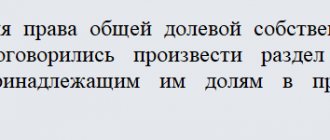What property is divided between former spouses?
Common property is divided equally. The main requirement is that it was purchased as a marriage. In the statement of claim for division of property, you include everything that you bought with your total income. This is real estate: apartments, garages, dachas. Cars, household appliances, securities, and deposits are divided. Dear ladies, diamonds are not considered the exclusive property of the wife; half must be given away.
Indivisible property
Everything that belonged to you before marriage will remain yours. Gifts, personal belongings, copyrights and results of intellectual activity are not shared. If you receive a fee for poetry, no one except you has the right to claim it. Even a former muse, that is, a wife.
The inheritance and things that the spouse uses in his activities are not divided. In short: a piano to a pianist, a car to a taxi driver. Children's belongings cannot be divided; they are given to the person with whom the child lives. There is no compensation for them.
You must justify all this in court. It's especially difficult with gifts. There is a rule - a transaction exceeding 10,000 rubles must be formalized in writing. If there is a gift agreement for a dacha, it is a gift. If not, it is common property. Keep this in mind.
How to draw up an agreement on the division of property: step-by-step instructions
The decision to divorce in most cases is not easy for married couples. In addition to emotional experiences, another headache is added - the division of jointly acquired property. Below is how to go through this procedure without unnecessary hassle.
Do you want to figure it out, but don’t have time to read the article? Lawyers will help
Entrust the task to professionals. Lawyers will complete the order at the cost you specify
289 lawyers on RTIGER.com can help with this issue
Solve the issue >
The simplest and most comfortable way to resolve the issue is to draw up an agreement. This is possible if the spouses do not have serious claims against each other and can peacefully divide what they have acquired over the years of marriage, without resorting to litigation. This is regulated by Article 36 of the Family Code of the Russian Federation. Despite the fact that the law does not approve the exact form of such an agreement, a number of requirements must be met when drawing it up - otherwise it may simply be invalid.
There are a couple of important points to note right away. Jointly acquired property is considered to be property acquired by the family after marriage. That is, it is pointless to apply for an apartment that a spouse bought long before the meeting of his other half, but you can compete for a car or financial asset given as a wedding gift.
It is worth mentioning right away that not only expensive property is subject to division - everything that you purchased or received as a gift as a couple can and should be divided. This includes a refrigerator given by my aunt for a wedding, jewelry, interior items, in a word, any things. In this case, gifts or inheritance received by one of the spouses are not subject to division. Also, the concluded agreement must be notarized. This is not a mandatory measure, but it may not be superfluous.
So, how to correctly draw up an agreement on the division of jointly acquired property?
- When drawing up an agreement, start with the basics: indicate your names, registration address, passport details, as well as your status - whether you are married (the agreement does not have to be concluded in connection with a divorce) or divorced.
- Indicate the purpose of the agreement - division of property, then list it. Here it is important to avoid general phrases like “all household appliances” and name in detail everything that you plan to share: a two-room apartment on Cherry Street with a market value of n million rubles (specify the share of each spouse), a black Nissan Almera of 2011, and that same two-chamber refrigerator Stinol.
- The contract must specify the date and place of its execution, as well as the location of the property itself at that moment.
- Indicate how the division will take place, what and in what shares will go to each spouse upon divorce.
- Be sure to note if one of the spouses voluntarily renounces some property in favor of the other, so that in the future an ambiguous situation does not arise and the agreement is not invalidated.
- The pages of the agreement must be numbered, and each sheet must have the signatures of both spouses.
As a rule, spouses divide jointly acquired property approximately equally. An obvious departure from the principle of equality creates a risk that the agreement will be declared invalid. What to do if a divorcing couple has children? According to the law, property is not distributed to minors, but parents can indicate in the agreement the share that should go to the child.
You can draw up such an agreement not only during divorce proceedings, but also while still in a strong relationship - this is a completely logical and normal way to protect yourself in the future. If you are not sure that you can draw up a contract yourself and take into account all legal aspects, contact a lawyer. The specialist will not only advise and help in drawing up the document, but will also, if possible, be able to smooth out rough edges in the dialogue between the spouses and lead them to consensus.
Opinion:
– There is one very funny pattern. In my practice, spouses first sit down at the negotiating table to come to an agreement on the division of property. But then they get bogged down in details and can't agree. They decide to sue. As a result, the court divides the property in approximately the same way as they initially tried to stipulate in the agreement. This happens because the rules of the section are still general. The court distributes property between spouses in such a way as to balance the share of each. That is, in the end it turns out that reaching an agreement on shore is faster and cheaper (costs for a lawyer are minimized, since the issue does not spill over into the courts, and the participation of a specialist is required only when preparing and agreeing on the text of the agreement). Anna Popovich, expert on family disputes at RTiger »
Still have questions? Lawyers will help. Click and choose the best
Entrust the task to professionals. Lawyers will complete the order at the cost you specify. You don’t have to study laws, read articles and figure out the issue yourself. Lawyers will do everything for you.
289 lawyers on RTIGER.com can help with this issue
Resolve the issue >
Procedure for drawing up an application
The claim is submitted to the court office. There are no special requirements for filing a claim for division of property. The courts are guided by Art. 131 – 132 Code of Civil Procedure of the Russian Federation. Please indicate the name of the court first. Then personal data and information about the defendant.
Describe the circumstances of the case: when the marriage was concluded and dissolved, whether there are children, with whom they live. Next, list the disputed property indicating its price. If agreements were signed, please attach them too. The next part is the requirements themselves and their rationale. At the end there is a list of attached documents and evidence, then a signature and date.
What is easier: without trial or through court?
Definitely, without trial. Dividing property through the court is more expensive: the amount of the state duty depends on the cost of the claim (the price of the disputed property), and the trial can last for many months. In addition, by entering into an agreement by mutual consent, you reduce the risk of an unequal division of all your property.
What are the consequences of dividing property without court?
Of course, the agreement on the division of property can be amended, or simply terminated by agreement of both spouses. In the first case, the latest version of this agreement will be valid, and in the second, the situation will return to the one that existed before the agreement, that is, the general rules for the division of property established by law will again apply.
Lawyer's advice: Remember that even a notarized agreement can be challenged in court, although the chances of success in this case will be negligible.
Watch the video in which a lawyer briefly explains the distinctive features of dividing property without a trial:
Statute of limitations
Within three years after the spouse finds out that his property rights are being violated, he can demand their restoration. For example, after a divorce and division, the husband left two apartments to his wife. Four years passed, he came to court, demanding to divide one of them. The court rejected him, citing a missed deadline.
The Supreme Court overturned this decision. The statute of limitations begins from the moment one of the spouses learns of a violation of their rights. The agreement stated that the wife was renting out the apartment, and the man thought that she was acting by agreement. When he found out about the sale, he came to court with a lawsuit. The three-year period has not expired, therefore, the ex-husband has the right to demand division.
If you find out that your spouse has hidden some part from the division, feel free to go to court. But you need to prove that you learned the news recently.
What if we conclude a marriage contract?
Those couples that can come to an agreement after the actual end of the relationship usually choose the option of a prenuptial agreement to divide property outside of court. In general, the logic is clear: various types of property regimes can be fixed in a marriage contract, and most importantly, it is possible to determine and fix who gets this or that property after a divorce without any special problems.
However, it is important to know the difference between a marriage contract and an agreement on the division of property: a marriage contract can be concluded before marriage and during marriage, and an agreement on the division of property can be concluded after the official divorce.
The concept of joint property of spouses
Before understanding the types of regime for joint property of spouses, it is necessary to understand what joint property of spouses is.
In accordance with Part 1 of Art. 34 of the RF IC, property acquired by them during marriage is recognized as joint property of spouses.
What kind of property acquired during marriage does the legislator recognize as joint (part 2 of article 34 of the RF IC)?
- any income (from labor, intellectual and entrepreneurial activities)
- pensions, benefits and other payments that do not have a specific purpose (for example, maternity capital is a targeted payment and is not subject to division);
- movable and immovable things;
- securities, shares, shares in the capital of credit institutions and other commercial organizations;
- other property acquired during marriage, regardless of which spouse it was acquired in the name of and/or which spouse contributed funds.
Choosing an option for dividing property
The above example of possible options for dividing property clearly shows that the most profitable option is any compromise.
Of course, it is good if people were able to agree upon marriage and draw up a marriage contract. Of course, this is not a panacea. A marriage contract can also be challenged if one of the spouses considers that the conditions in the changed situation are no longer beneficial for him.
Litigation is long, expensive and not always satisfying
. Even ex-spouses can come to an agreement and do without an arbiter in the person of the judiciary, but decide everything on their own and come to exactly the result that suits both parties.
Design features
If the specified agreement was drawn up on several sheets, each of them must be signed by the parties, after which the pages must be sewn together and sealed. The specified agreement is signed with one’s own hand; in addition to the signature, experts recommend that the parties indicate their full names. The transaction must reflect information regarding the volume of property to be divided.
According to the general rule, the document can include both the entire property and its individual parts, but in the second case, several similar agreements will have to be drawn up. It is the latter option that is used by spouses when transferring rights exclusively to an apartment.
This agreement does not imply a mandatory division of the apartment equally. Housing can be divided between spouses into unequal shares, for example, 1/3 and 2/3. The law does not provide for the obligation to motivate one or another version of the section; however, such an approach may be appropriate to justify that a deviation from the principle of equality is not the result of a technical error.
In addition, in the agreement, spouses can establish the procedure for using the divided apartment. For example, in the case of dividing a three-room apartment, each spouse will have the right to use one pre-selected room, and the third, in turn, will go to the child.
How is it certified and registered?
An agreement on residential real estate between spouses is subject to mandatory notarization. A husband and wife have the right to draw up the text of the document either in their own hand and present it to a notary officer for verification for compliance with the norms of current legislation, or use a ready-made template for such an agreement available to the notary. But it would still be preferable to draw up a document with the involvement of an independent lawyer, since this option involves a more specific and accurate reflection of the current property situation of the spouses, and also reflects in more detail the desires and preferences of the latter regarding the future fate of the divided property.
If the spouses do not provide for a different procedure, the agreement is considered concluded from the moment it is signed by the parties. Also, a transaction can gain legal force if, according to the contents of this document, the condition for this is the occurrence of a certain event, for example, a divorce.
To complete the procedure for dividing an apartment, spouses must contact the Rosreestr authorities to register their property rights to new shares of the apartment or to the housing itself as a whole, providing the appropriate agreement to the specified authority.









